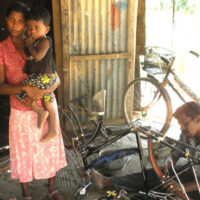Sri Lanka’s Status in Achieving Sustainable Development Goals on Reduced Inequalities and Shared Prosperity
Hemesiri Kotagama and Dilshani Ranawaka
“Sustainable Prosperity is Shared Prosperity”
Introduction: Sustainable development is a development process that best satisfies the present generation, whilst conserving options to best satisfy the future generations. In order to achieve sustainable development, the present society should make judicious decisions on; economic progress, achieving social harmony and rational use of environmental and natural resources. The overarching Sri Lankan development policy is to achieve sustainable development. Sri Lanka has made an international commitment to achieve global sustainable development by partnering with the United Nations (UN).
Among the different expectations of social harmony in sustainable development; Reduced Inequalities is the 10th Goal among 17 Sustainable Development Goals (SDG) that the UN has identified. The first indicator of measurement of progress towards Reduced Inequalities is in relation to reducing income inequalities leading to shared prosperity. Shared prosperity is when national income growth and reduction in income inequalities are achieved concomitantly. Thus the stated UN target is: “By 2030, countries progressively achieve and sustain income growth of the bottom 40 per cent of the population at a rate higher than the national average income growth”. Across 119 countries, prior to the covid pandemic, more than half of those countries have achieved this target (https://sdgs.un.org/). This article is an assessment of Sri Lanka’s progress in achieving the 10th SDG on Reducing Income Inequalities and achieving shared prosperity based on UN SDG measurement indicator 10.1. A brief review on the concept of reduced inequalities and shared prosperity is provided and then the empirical measurement on Sri Lanka’s status on achieving the SDG on reduced inequality in shared prosperity is presented.
Measurement of Reduced Inequalities in Income and Shared Prosperity: Increased economic growth and reduced income inequalities are both perceptibly desirables. It was Arthur Okun in 1975, who initiated an intellectual debate on achieving the twin possibilities of economic growth and reduced income inequalities by his treatise titled Equality and Efficiency: The big Tradeoff. While the intellectual debate continues, in reality the choice between equality and efficiency is executed by the political economic institutions, and is impacting the society. The social expectation is that a desired blend of efficiency and equality is achieved, where prosperity of economic growth is equitably shared. Whether society is achieving the desired blend of efficiency and equality could only be judged in objective terms if these concepts are measurable. The measurement of efficiency through economic growth (growth of per capita income) is comprehensible. The measurement of equitable sharing of prosperity of economic growth is ambiguous. Any good measure should be simple, such that it is understood by all in society and particularly policy makers. The UN and World Bank considers that reduced inequalities could be examined by measuring the income growth of the bottom 40% of income earners of society. There are practical and conceptual reasons that justify the choice of the measuring income gains of bottom 40% as the cut-off, to measure shared prosperity (Basu, 2013). A society would be achieving shared prosperity (income growth with reduced inequalities) if it could, progressively achieves and sustain Income Growth of the Bottom 40 per cent of the population (IGB) at a rate higher than the Income Growth National Average Income (IGN). In summary if IGB>IGN (IGB/IGN > 1) such a country is achieving shared prosperity of economic growth and equitable sharing of economic growth. Annualized growth is estimated when estimating growth of periods of more than a year.
Empirical Estimates of Reduced Inequalities in Income and Shared Prosperity in Sri Lanka: Table 1, provides the estimates of IGB/IGN ratio based on data from reports on Household Income and Expenditure Surveys of Sri Lanka published by the Department of Census and Statistics (http://www.statistics.gov.lk/).
As observed in Table 1, the IGB/IGN has been 1 or more, during 2006 to 2019, indicating that Sri Lanka’s development has achieved shared prosperity of sharing economic growth with the poorest 40% of the population. This is corroborated by the declining Gini coefficient during this period.
However, there are two major issue of concern to address on shared prosperity of development in Sri Lanka. First is to address whether an income inequality represented by a Gini coefficient of more than 0.5 is socially acceptable as optimal and whether the rate of decline in the Gini coefficient is sufficient. Conscious choice and implementation of policies could perhaps achieve faster and lower inequalities, as experienced in the immediate period of post-independent Sri Lanka. Second is to address the expected adverse implications of the recent economic crisis on shared prosperity of development of Sri Lanka.
Table 1. Estimates of IGB/IGN ratios of Sri Lanka during 2006-2019
References
Basu, K. (2013) Shared Prosperity and the Mitigation of Poverty in Practice and in Precept, Policy Research Working Paper 6700, The World Bank. Okun, A. M. (2015). Equality and Efficiency: The Big Tradeoff. Brookings Institution Press. http://www.jstor.org/stable/10.7864/j.ctt13wztjk
The TIER (The Inequality Report) is a flagship project undertaken by Centre for Poverty Analysis (CEPA), with YUMA Foundation and Janashakthi Foundation as partner organizations that analyses the state, consequences and reasons of inequality in Sri Lanka and share its findings with the public.
Disclaimer: The views expressed in this article are those of the authors and do not necessarily reflect the views and policies of CEPA










